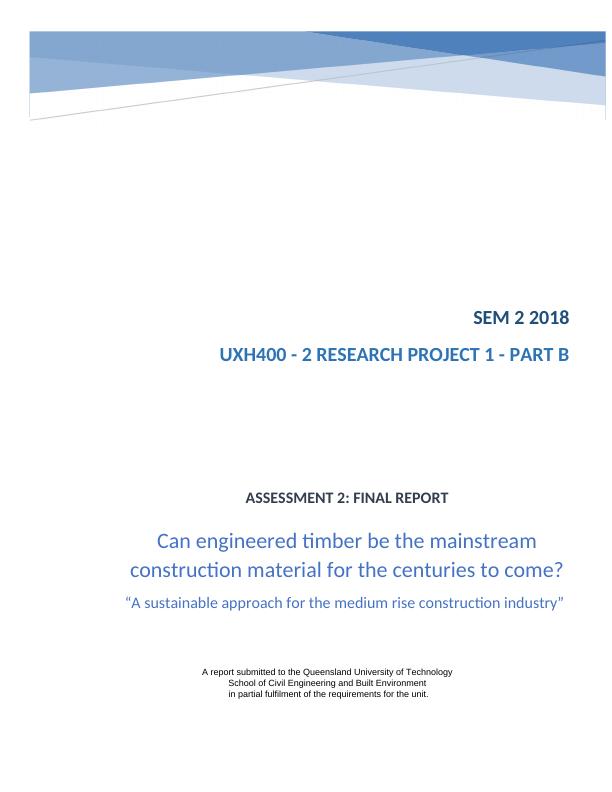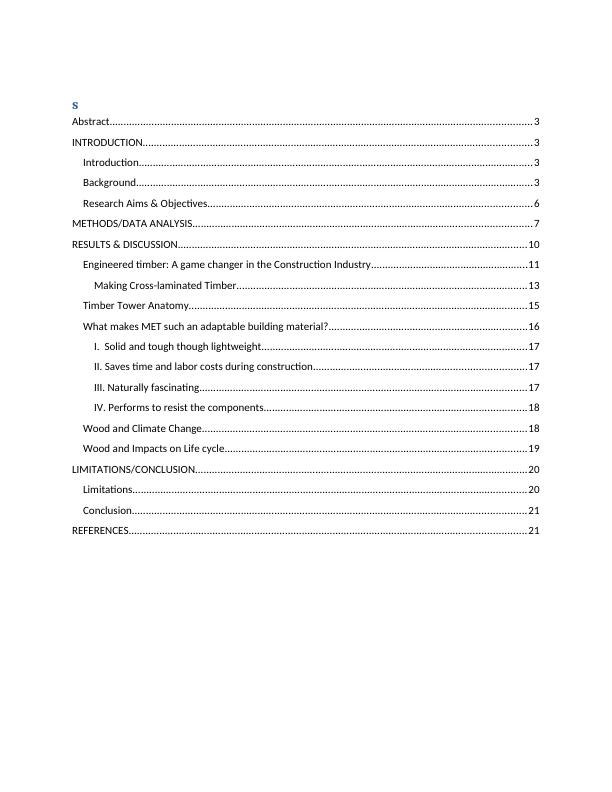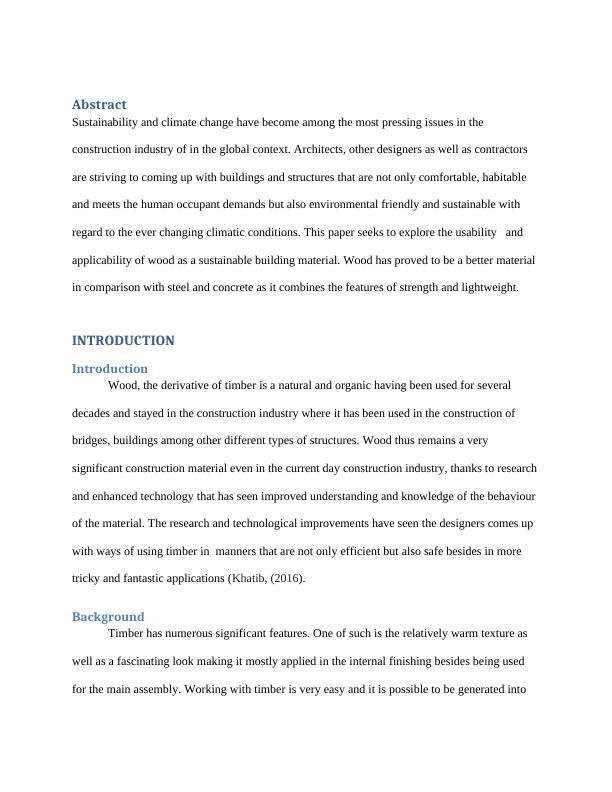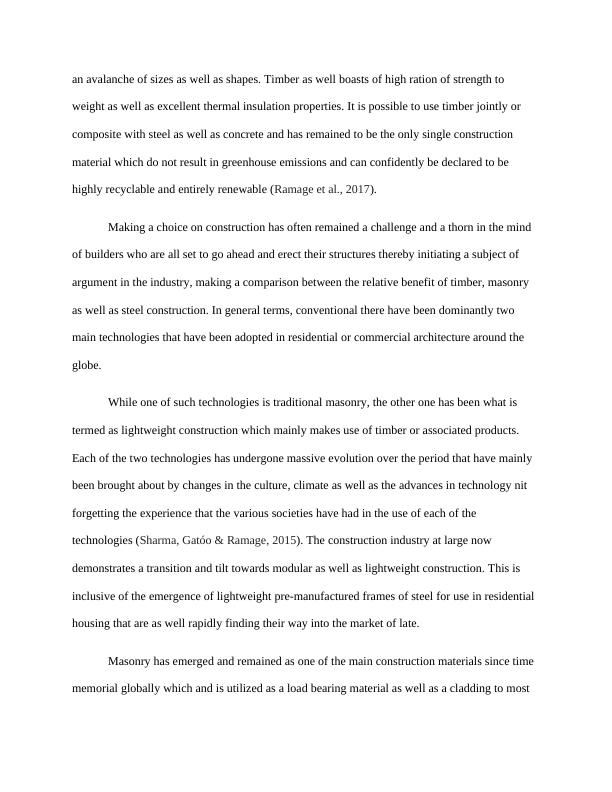Can Engineered Timber be the Mainstream Construction Material for the Centuries to Come?
Added on 2023-06-03
25 Pages5858 Words271 Views
Content
A report submitted to the Queensland University of Technology
School of Civil Engineering and Built Environment
in partial fulfilment of the requirements for the unit.
SEM 2 2018
UXH400 - 2 RESEARCH PROJECT 1 - PART B
ASSESSMENT 2: FINAL REPORT
Can engineered timber be the mainstream
construction material for the centuries to come?
“A sustainable approach for the medium rise construction industry”
A report submitted to the Queensland University of Technology
School of Civil Engineering and Built Environment
in partial fulfilment of the requirements for the unit.
SEM 2 2018
UXH400 - 2 RESEARCH PROJECT 1 - PART B
ASSESSMENT 2: FINAL REPORT
Can engineered timber be the mainstream
construction material for the centuries to come?
“A sustainable approach for the medium rise construction industry”

s
Abstract.......................................................................................................................................................3
INTRODUCTION...........................................................................................................................................3
Introduction.............................................................................................................................................3
Background..............................................................................................................................................3
Research Aims & Objectives....................................................................................................................6
METHODS/DATA ANALYSIS.........................................................................................................................7
RESULTS & DISCUSSION.............................................................................................................................10
Engineered timber: A game changer in the Construction Industry........................................................11
Making Cross-laminated Timber........................................................................................................13
Timber Tower Anatomy.........................................................................................................................15
What makes MET such an adaptable building material?.......................................................................16
I. Solid and tough though lightweight...............................................................................................17
II. Saves time and labor costs during construction............................................................................17
III. Naturally fascinating.....................................................................................................................17
IV. Performs to resist the components..............................................................................................18
Wood and Climate Change....................................................................................................................18
Wood and Impacts on Life cycle............................................................................................................19
LIMITATIONS/CONCLUSION.......................................................................................................................20
Limitations.............................................................................................................................................20
Conclusion.............................................................................................................................................21
REFERENCES..............................................................................................................................................21
Abstract.......................................................................................................................................................3
INTRODUCTION...........................................................................................................................................3
Introduction.............................................................................................................................................3
Background..............................................................................................................................................3
Research Aims & Objectives....................................................................................................................6
METHODS/DATA ANALYSIS.........................................................................................................................7
RESULTS & DISCUSSION.............................................................................................................................10
Engineered timber: A game changer in the Construction Industry........................................................11
Making Cross-laminated Timber........................................................................................................13
Timber Tower Anatomy.........................................................................................................................15
What makes MET such an adaptable building material?.......................................................................16
I. Solid and tough though lightweight...............................................................................................17
II. Saves time and labor costs during construction............................................................................17
III. Naturally fascinating.....................................................................................................................17
IV. Performs to resist the components..............................................................................................18
Wood and Climate Change....................................................................................................................18
Wood and Impacts on Life cycle............................................................................................................19
LIMITATIONS/CONCLUSION.......................................................................................................................20
Limitations.............................................................................................................................................20
Conclusion.............................................................................................................................................21
REFERENCES..............................................................................................................................................21

Abstract
Sustainability and climate change have become among the most pressing issues in the
construction industry of in the global context. Architects, other designers as well as contractors
are striving to coming up with buildings and structures that are not only comfortable, habitable
and meets the human occupant demands but also environmental friendly and sustainable with
regard to the ever changing climatic conditions. This paper seeks to explore the usability and
applicability of wood as a sustainable building material. Wood has proved to be a better material
in comparison with steel and concrete as it combines the features of strength and lightweight.
INTRODUCTION
Introduction
Wood, the derivative of timber is a natural and organic having been used for several
decades and stayed in the construction industry where it has been used in the construction of
bridges, buildings among other different types of structures. Wood thus remains a very
significant construction material even in the current day construction industry, thanks to research
and enhanced technology that has seen improved understanding and knowledge of the behaviour
of the material. The research and technological improvements have seen the designers comes up
with ways of using timber in manners that are not only efficient but also safe besides in more
tricky and fantastic applications (Khatib, (2016).
Background
Timber has numerous significant features. One of such is the relatively warm texture as
well as a fascinating look making it mostly applied in the internal finishing besides being used
for the main assembly. Working with timber is very easy and it is possible to be generated into
Sustainability and climate change have become among the most pressing issues in the
construction industry of in the global context. Architects, other designers as well as contractors
are striving to coming up with buildings and structures that are not only comfortable, habitable
and meets the human occupant demands but also environmental friendly and sustainable with
regard to the ever changing climatic conditions. This paper seeks to explore the usability and
applicability of wood as a sustainable building material. Wood has proved to be a better material
in comparison with steel and concrete as it combines the features of strength and lightweight.
INTRODUCTION
Introduction
Wood, the derivative of timber is a natural and organic having been used for several
decades and stayed in the construction industry where it has been used in the construction of
bridges, buildings among other different types of structures. Wood thus remains a very
significant construction material even in the current day construction industry, thanks to research
and enhanced technology that has seen improved understanding and knowledge of the behaviour
of the material. The research and technological improvements have seen the designers comes up
with ways of using timber in manners that are not only efficient but also safe besides in more
tricky and fantastic applications (Khatib, (2016).
Background
Timber has numerous significant features. One of such is the relatively warm texture as
well as a fascinating look making it mostly applied in the internal finishing besides being used
for the main assembly. Working with timber is very easy and it is possible to be generated into

an avalanche of sizes as well as shapes. Timber as well boasts of high ration of strength to
weight as well as excellent thermal insulation properties. It is possible to use timber jointly or
composite with steel as well as concrete and has remained to be the only single construction
material which do not result in greenhouse emissions and can confidently be declared to be
highly recyclable and entirely renewable (Ramage et al., 2017).
Making a choice on construction has often remained a challenge and a thorn in the mind
of builders who are all set to go ahead and erect their structures thereby initiating a subject of
argument in the industry, making a comparison between the relative benefit of timber, masonry
as well as steel construction. In general terms, conventional there have been dominantly two
main technologies that have been adopted in residential or commercial architecture around the
globe.
While one of such technologies is traditional masonry, the other one has been what is
termed as lightweight construction which mainly makes use of timber or associated products.
Each of the two technologies has undergone massive evolution over the period that have mainly
been brought about by changes in the culture, climate as well as the advances in technology nit
forgetting the experience that the various societies have had in the use of each of the
technologies (Sharma, Gatóo & Ramage, 2015). The construction industry at large now
demonstrates a transition and tilt towards modular as well as lightweight construction. This is
inclusive of the emergence of lightweight pre-manufactured frames of steel for use in residential
housing that are as well rapidly finding their way into the market of late.
Masonry has emerged and remained as one of the main construction materials since time
memorial globally which and is utilized as a load bearing material as well as a cladding to most
weight as well as excellent thermal insulation properties. It is possible to use timber jointly or
composite with steel as well as concrete and has remained to be the only single construction
material which do not result in greenhouse emissions and can confidently be declared to be
highly recyclable and entirely renewable (Ramage et al., 2017).
Making a choice on construction has often remained a challenge and a thorn in the mind
of builders who are all set to go ahead and erect their structures thereby initiating a subject of
argument in the industry, making a comparison between the relative benefit of timber, masonry
as well as steel construction. In general terms, conventional there have been dominantly two
main technologies that have been adopted in residential or commercial architecture around the
globe.
While one of such technologies is traditional masonry, the other one has been what is
termed as lightweight construction which mainly makes use of timber or associated products.
Each of the two technologies has undergone massive evolution over the period that have mainly
been brought about by changes in the culture, climate as well as the advances in technology nit
forgetting the experience that the various societies have had in the use of each of the
technologies (Sharma, Gatóo & Ramage, 2015). The construction industry at large now
demonstrates a transition and tilt towards modular as well as lightweight construction. This is
inclusive of the emergence of lightweight pre-manufactured frames of steel for use in residential
housing that are as well rapidly finding their way into the market of late.
Masonry has emerged and remained as one of the main construction materials since time
memorial globally which and is utilized as a load bearing material as well as a cladding to most

of the frames structures. Block and brick masonry have remained the material that are used for
construction and are used by extension in all types of construction. The modern masonry
structure of today are however slim when compared against the ancient constructions that used
the same materials; adopting the use of the latest materials as well as the methods of design.
Steel frame construction has as well been used both in commercial and residential housing before
and is still in use. The construction of steel frame is done using light weight gauge steel even
though some of the steel frames are prefabricated. Among the challenges that may crop in during
the use of either of the two construction materials include disputes and delays emanating from
coming up with new regulations for building as well as agreement certificates, suppliers to the
conventional building sector (Dickson & Parker, 2015).
Following the shortcomings associated with the use of steel and concrete as the main
building material, a miracle building material has set in- a construction material that is as much
environmentally friendly as that which removes carbon from the environment and atmosphere as
opposed to increasing the volume of the already existing capacity. Timber is one of those
construction materials with which assemblages are able to go up at very high speeds which in
turn lower the nose and levels of disruptions at the building sites during construction.
The odds of timber building and of timber utilization as load-bearing material rely upon
the quality criteria. The most vital factor is the practical utilization of timber with the end goal to
build its use in development furthermore, make it focused in contrast with other constructional
materials. Timber as a material for supporting frameworks is a characteristic introduction for
utilization of wood in further developments. Subsequently, a wide range of wood as well as
timber, from round wood to squared timber via composite regions manufactured from sheets as
construction and are used by extension in all types of construction. The modern masonry
structure of today are however slim when compared against the ancient constructions that used
the same materials; adopting the use of the latest materials as well as the methods of design.
Steel frame construction has as well been used both in commercial and residential housing before
and is still in use. The construction of steel frame is done using light weight gauge steel even
though some of the steel frames are prefabricated. Among the challenges that may crop in during
the use of either of the two construction materials include disputes and delays emanating from
coming up with new regulations for building as well as agreement certificates, suppliers to the
conventional building sector (Dickson & Parker, 2015).
Following the shortcomings associated with the use of steel and concrete as the main
building material, a miracle building material has set in- a construction material that is as much
environmentally friendly as that which removes carbon from the environment and atmosphere as
opposed to increasing the volume of the already existing capacity. Timber is one of those
construction materials with which assemblages are able to go up at very high speeds which in
turn lower the nose and levels of disruptions at the building sites during construction.
The odds of timber building and of timber utilization as load-bearing material rely upon
the quality criteria. The most vital factor is the practical utilization of timber with the end goal to
build its use in development furthermore, make it focused in contrast with other constructional
materials. Timber as a material for supporting frameworks is a characteristic introduction for
utilization of wood in further developments. Subsequently, a wide range of wood as well as
timber, from round wood to squared timber via composite regions manufactured from sheets as

well as squared timber, alongside additionally glue laminated timber, compressed wood, and so
on, particularly when joined using various stuff, must be created as well as utilized (Mayo,
2015).
A few favourable circumstances incorporate light weight, reusing, simple to erect as well
as crush warm features and so forth. The two greatest impediments are invasion of creepy
crawlies as well as fires and may be talked about later in this investigation. Diverse materials are
being utilized in various nations as made reference to brick work are being utilized for most part
for the development of private lodging what's more, steel more for greater structures such as
distribution centers and so forth. Wood isn't generally utilized in development of lodging in the
world despite more usually utilized in different nations like America however is showing up. The
main concern in this study thus seeks to extensively address the possibility of using engineered
timber as the mainstream construction material for the coming centuries following an analysis of
such factors as the cost, efficiency, availability, environmental concerns among other issues. A
study is conducted to establish the benefits, shortcomings as well as the innovative ideas behind
engineered timber that would render it usable or otherwise not adoptable as the mainstream
construction material in the future centuries (Coombs, 2018).
Research Aims & Objectives
The aim of this exploration is to assess the capacity and achievability of designed timber as
an essential development material for medium ascent structures. Research to date show the
development business is one of the real players for Greenhouse Gas (GHG) outflows and
recognizes the need to embrace imaginative and supportable development strategies to moderate
the issues in connection to it. Notwithstanding that, specialists' sentiments following their
on, particularly when joined using various stuff, must be created as well as utilized (Mayo,
2015).
A few favourable circumstances incorporate light weight, reusing, simple to erect as well
as crush warm features and so forth. The two greatest impediments are invasion of creepy
crawlies as well as fires and may be talked about later in this investigation. Diverse materials are
being utilized in various nations as made reference to brick work are being utilized for most part
for the development of private lodging what's more, steel more for greater structures such as
distribution centers and so forth. Wood isn't generally utilized in development of lodging in the
world despite more usually utilized in different nations like America however is showing up. The
main concern in this study thus seeks to extensively address the possibility of using engineered
timber as the mainstream construction material for the coming centuries following an analysis of
such factors as the cost, efficiency, availability, environmental concerns among other issues. A
study is conducted to establish the benefits, shortcomings as well as the innovative ideas behind
engineered timber that would render it usable or otherwise not adoptable as the mainstream
construction material in the future centuries (Coombs, 2018).
Research Aims & Objectives
The aim of this exploration is to assess the capacity and achievability of designed timber as
an essential development material for medium ascent structures. Research to date show the
development business is one of the real players for Greenhouse Gas (GHG) outflows and
recognizes the need to embrace imaginative and supportable development strategies to moderate
the issues in connection to it. Notwithstanding that, specialists' sentiments following their

End of preview
Want to access all the pages? Upload your documents or become a member.
Related Documents
Construction Management Australia Research 2022lg...
|12
|2347
|40
Construction Management Assignment Reportlg...
|12
|2889
|31
Green Construction Technology Research Paper 2022lg...
|40
|12295
|22
Pedestrian Concrete Timber Bridgelg...
|18
|4776
|142
Overcoming Barriers for Using Cross Laminated Timber in Multi-Storey Constructionlg...
|19
|5904
|251
Advantages and Disadvantages of Various Options for Internal Wallslg...
|13
|1907
|62
